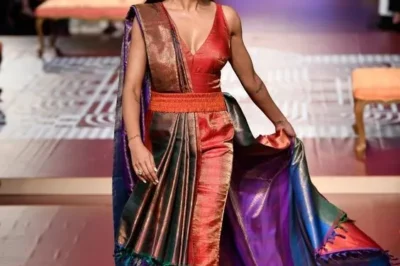Ethnic wear is a timeless aspect of Indian fashion, deeply rooted in the country’s cultural heritage. However, in today’s fashion landscape, modern ethnic fashion is all about blending traditional elements with contemporary styles to create unique, sophisticated looks. By incorporating fusion elements and rethinking how we wear classic pieces, Indian ethnic outfits can be easily transformed to suit any occasion—from casual to formal. Here’s how to elevate your ethnic wear with a modern twist.
1. Embrace Fusion Fashion
One of the most popular trends in modern ethnic fashion is fusion fashion, which combines traditional pieces with modern elements. Pairing a saree with a crop top or a lehenga with a denim jacket adds a youthful and fresh vibe to a classic look. You can also experiment by mixing different cultural elements, like pairing a kurta with tailored trousers or wearing a traditional dupatta with a modern jumpsuit. Fusion fashion gives you the flexibility to style ethnic wear in innovative ways while maintaining its cultural essence.
2. Play with Accessories
Accessories are key when it comes to styling Indian ethnic outfits for a contemporary look. Modern jewelry, like statement chokers, layered necklaces, or geometric earrings, can bring a fresh perspective to your traditional attire. For a more relaxed vibe, pair your ethnic wear with belts, scarves, or even sneakers. The right accessories can instantly modernize an outfit, allowing you to create a balance between tradition and modernity.
3. Mix and Match Fabrics and Textures
A great way to bring a contemporary touch to ethnic wear is by mixing different fabrics and textures. For example, pair a rich silk kurta with leather leggings, or style a flowy cotton anarkali with a sequined jacket for an interesting contrast. The combination of traditional fabrics with bold, modern textures creates a visually appealing and stylish look. Don’t be afraid to experiment—fashion is all about expressing your personality through your outfits.
4. Modern Blouse Designs with Sarees
The classic saree is a staple in Indian ethnic outfits, but the blouse is where you can truly experiment. Opt for blouses with contemporary cuts, like off-the-shoulder designs, halter necks, or even capes, to add a modern edge to your saree. Lace, sheer fabrics, and embroidered blouses paired with a traditional saree create a contemporary ethnic style that’s both elegant and trendy. You can also try wearing your saree in an unconventional drape for a fresh and youthful look.
5. Minimalist Styling for a Modern Touch
When styling traditional wear, minimalism can go a long way in achieving a modern look. A simple, well-tailored kurta with minimal embroidery or print can be paired with straight pants or palazzos for an effortlessly chic outfit. Stick to neutral or pastel shades for a clean, polished look, and accessorize with subtle jewelry. Minimalist styling gives your outfit a contemporary feel without overwhelming the traditional elements.
6. Experiment with Contemporary Ethnic Silhouettes
Contemporary ethnic styles are all about experimenting with silhouettes. Asymmetrical kurtas, dhoti pants, and sharara sets are just a few examples of modern cuts that add a twist to traditional wear. These contemporary silhouettes are not only comfortable but also give a unique flair to ethnic wear, making it more versatile for different occasions. Try pairing a long asymmetrical kurta with ankle-length pants, or style a sharara with a modern, structured jacket to add depth and dimension to your look.
Conclusion
Styling ethnic wear for contemporary fashion is all about striking the right balance between tradition and innovation. By experimenting with fusion fashion, modern accessories, and unconventional cuts, you can create unique looks that reflect your personal style while honoring the timeless elegance of Indian ethnic outfits. Whether you’re dressing up for a formal event or looking for a casual day out, these styling tips for traditional wear will help you reinvent your wardrobe with a fresh, modern twist.








Leave a Reply